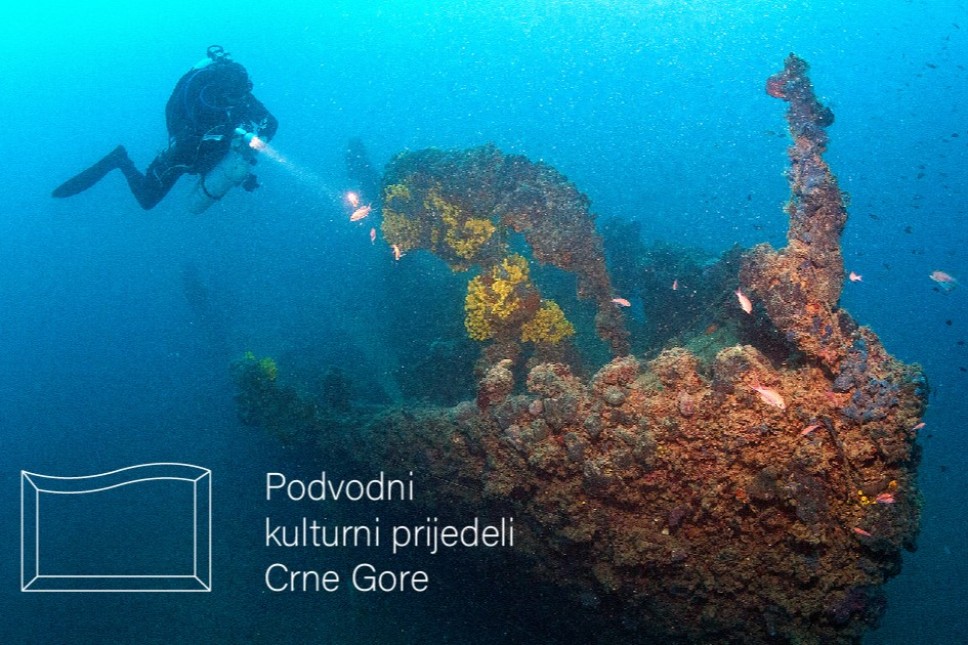Laboratorija za arheologiju pomorstva pokreće multidisciplinaran i multidimenzionalan projekat Podvodni kulturni predjeli Crne Gore

Laboratorija za arheologiju pomorstva, Centar za istraživanja, inovacije i preduzetništvo, Pomorski Fakultet Kotor, Univezitet Crne Gore
Kapitalizujući opremu i kapacitete razvijene kroz EU projekte, Laboratorija za arheologiju pomorstva pokreće multidisciplinaran i multidimenzionalan projekat Podvodni kulturni predjeli Crne Gore.
Projekat se realizuje se kroz međuinstitucionalnu saradnju na državnom i lokalnom nivou kroz postojeće sinergije kreirane kroz implementaciju prethodnih projekata.
Misija
Misija projekta “Podvodni kulturni predjeli Crne Gore” (PKPCG) je da, multidisciplinarnim pristupom, pomoću inovativnih tehnologija, potpuno osvijetli i učini dostupnim raznovrsne kulturno-istorijske aspekte podvodne kulturne baštine Crne Gore.
Proučavajući olupine brodova, navigacione rute, luke, sidrišta i druge ostatke ljudskih aktivnosti duž crnogorske obale, inicijativa će doprineti boljoj institucionalnoj prepoznatosti ovog resursa, prenjeti javnosti kulturno-istorijske poruke podvodne kulturne baštine kroz različite medijske kanale i uticati na promociju i razvoj turizma.
Ciljevi
Tradicionalna i digitalna 2D i 3D dokumentacija lokaliteta podvodne kulturne baštine, kreiranje baze podatka, online geoportala, platformi i virtuelnih muzeja, podsticanje razvoja nauka povezanih sa istraživanjem podvodne kulturne baštine, podizanje institucionalnih kapaciteta, veća akademska vidljivost istraživača i institucija, omogućavanje javne dostupnosti znanja i kulturno istorijskih poruka koje podvodna kulturna baština prenosi kroz različite inovativne digitalne forme i medije, edukativni programi, promocija podvodnog turizma i turističke atraktivnosti podvodne kulturne baštine Crne Gore.
Sažetak
Projekat „Podvodni kulturni predjeli Crne Gore“ ima za cilj da kroz multidisciplinaran naučni pristup i širok spektar aktivnosti doprinese boljoj osvijetljenosti podvodne kulturne baštine Crne Gore i prenese njene kulturno-istorijske poruke javnosti.
Primarni zadatak inicijative je da primjenom inovativnih metoda 3D i 2D digitalizacije, dokumentuje i interpretira lokalitete podvodne kulturne baštine kako bi se kreirala baza podataka koja bi u multi-institucionalnom kontekstu, kroz inovativna digitalno-tehnološka rješenja, podržala procese pravne zaštite, praćenja, očuvanja i promocije ovog kulturnog resursa.
Različite aktivnosti u okviru inicijative će pozitivno uticati na razvoj načnih disciplina za istraživanje podmorja i podvodne kulturne baštine, te povećati internacionalnu vidljivost i zastupljenost crnogorskih institucija i istraživača. Učešćem u implementaciji projekta, kroz direktan rad i edukativne aktivnosti, institucije u lancu podvodne kulturne baštine će usvojiti savremena znanja i viještine digitalne dokumentacije i interpretacije podvodnih prostornih i 3D podataka dobijenih metodama daljinske detekcije, što bi za ishod imalo osavremenjivanje, podizanje kapaciteta, kreiranje institucionalnih sinergija, kao i implementaciju modernih mehanizama zaštite i upravljanja podvodnom kulturnom baštinom.
Inicijativa će imati snažan edukativni efekat na široku javnost sa ciljem prenošenja poruke narednim generacijama i podizanja svijesti o podvodnoj kulturnoj baštini i značaju njenog očuvanja. Realizovaće se kroz slijedeće forme:
- Edukativne programe,
- Kurseve,
- Ljetnje škole,
- Inovativne interaktivne izložbe,
- Izložbe fotografija i 3D modela,
- Virtuelne muzeje,
- Posjete lokalitetima podvodne kulturne baštine pomoću virtuelne realnosti,
- Dokumentarne video, radio i TV forme
- Kampanju u tradicionalnim i digitalnim medijima
Sistematskom naučnom obradom lokaliteta podvodne kulturne baštine, adekvatnom komunikacijom rezultata, kreiranjem baze podataka za različite vidove promocije, izradom višejezičnog ronilačkog vodiča, edukacijom o podvodnim atraktivnostima, inicijativa će značajno uticati na razvoj različitih oblika podvodnog turizma i profilisanja Crne Gore kao atraktivne destinacije.
Metodologija inicijative se zasniva na bezkontaktnom dokumentovanju tradicionalnim metodama, vizuelnom observacijom, snimanjem foto i video kamerama, zatim inovativnim metodama fotogrametrije i daljinske detekcije senzorima i sonarima, bez narušavanja integriteta lokaliteta. Lokaliteti obuhvaćeni ovom inicijativom su odabrani po svojim kulturno istorijskim osobenostima i karakteristikama, a po kriterijumima proizašlim iz UNESCO Konvencije o zaštiti podvodne kulturne baštine 2001, čijim okvirima i preporukama se vode sve aktivnosti.

